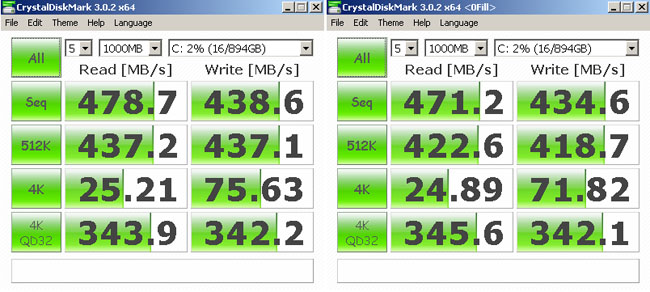This article is more than 1 year old
Review: Crucial M500 960GB SSD
A consumer-friendly drive with class-leading tech, capacity
The thin controller
The M500 series use the third-generation Marvell 88SS9187 controller - also used by Plextor in its M5 Pro SSD - but with Crucial’s hand in the firmware development. The controller itself is based on a dual-core Marvell 88FR102 V5 CPU capable of running eight NAND Flash channels through an interface that supports the latest ONFI (Open NAND Flash Interface) 3.0 specification. The latest incarnation of the ONFI interface brings with it such goodies as lower voltages, on-die termination and perhaps even more importantly an increase in interface speed from ONFI 2.0’s 200MB/s to a very healthy 400MB/s. For cache purposes, the 88SS9187 supports up to 1GB of 800MHz DDR 2 and DDR 3 for mapping algorithms.

Inside the Marvell 88SS9187
As with most modern drives, the M500 supports 256-bit AES encryption but Crucial has beefed up the security still further by adding support for both TCG Opal 2.0 and IEEE 1667 specifications. Having the Opal 2.0 support means that that you can use third-party encryption to make your system even more secure. It also means that the drive is fully compatible with the BitLocker encryption built into Windows 8. It’s the first SSD with explicit support for this feature.
If you look at the drive’s board, you’ll notice something a little different from conventional mainstream drives and a feature that is normally more at home on enterprise-grade SSDs. The bank of capacitors above the controller and one of the two cache chips ensure that should there be a power failure, the drive has sufficient juice to complete any writes it is performing. This is the first drive with this feature aimed at the consumer market that I have seen.

ATTO results
Another feature normally seen in enterprise grade drives is true thermal management. Should the controller temperature exceed 70°C, the firmware instructs the drive to reduce performance until it returns to normal operating temperature. This is done without changing the Sata PHY rate so making the operation transparent to the host. Very clever.
Yet another first is the drive’s support for Device Sleep (DEVSLP), a new standard which should be part of the chipset specification for Intel's Haswell processor technology when it arrives.

CrystalDiskMark results: uncompressed data on the left, compressed data on the right
As I say, Crucial quote sequential read/write figures for the M500 960GB of 500MB/s and 400MB/s, respectively, and this is pretty much what I found when I tested the drive with the ATTO benchmark: 539MB/s reads, 451MB/s writes. As the drive uses a Marvell controller it doesn’t suffer any performance loss when it comes to using compressed or uncompressed data, as can be seen from the two sets of CrystalDiskMark results: 478MB/s reads, 438MB/s writes when tested at the default uncompressed data mode versus 471MB/s reads, 434MB/s writes when the benchmark was switched to using compressed data.

AS SSD benchmark results
It’s the same story in the AS SSD benchmark. The default incompressible test produces sequential read/write scores of 493MB/s and 437MB/s, respectively. Switching to AS SSD’s compressible data test, the drive doesn’t miss a beat, producing a read score of 497MB/s and writes of 430MB/s.
The Reg Verdict
Crucial’s M500 SSD series has some interesting and forward-thinking technology built in, and it’s the first family of solid-state drives that uses the latest 128Gb NAND chip technology. The flagship 960GB drive is the real star of the family. It’s one of the most important drives launched for quite some time: a large capacity drive which, while still expensive relative to HDDs, could usher in cheaper and larger capacity SSDs in the near future. ®

